|

Here is the example for the arc ball activity , which is explained below , and make sure with all activities that
alternatives and adjustments are made to meet the needs of all students . Please note when viewing the diagrams
that the colors usually denote the students(circular) .
Here are some games and activities along with diagrams for the intermediuate to middle school grades or the younger students
with alternatives and adjustments . Use different equipment , change the rules and the space for appropriate and develomental
skills and games. Check back often until all 33 games and activities are presented .
Before any game is contested , make sure the skills are taught in a scope and sequence or rubric approach :
Arc
ball - arrange the students on each side of the basketball court on the 3 point arc . Place a traffic cone at
the center of the arc to distinguish the two groups . Hand out pinnies or game jerseys to each group . Choose 2-4 players
from each group to start the action . The other players are aligned behind frisbees , which are placed on the arc circle.
Give the basketball to one group . On a signal , the outside group passes the ball to any of their players . before a shot
can be taken , the ball must be passed at least three times , which includes the teammates behind the frisbees. Any bad pass
or errant shot goes to the other group . If a shot is made , the opposing team continues play from a teammates pass behind
the frisbees.
Ater a designated time limit , the players move up one frisbee toward the center . The group(s) that just
played go to the end of the line and also move up one space. Alternatives may be to allow dribbling , add or subtract passes
or players. If there is the opportunity to have two side baskets or even a portable set up , then there will be four games
at once.
Baserunning - place cones about 20 feet apart all around the gym with two designated bases( or
makeshift) at the same distance . Assign a student at each cone , who will be standing beside a cone . Another student will
be a runner , who will stand near the base. ( color blue in the diagram). On a signal , one of the students at the cone
will roll the ball to the student on the opposite side . The runner will try to make it back and forth before the ball is
returned to the first person who rolled the ball . During the action , switch places so each student will have the opportunity
at each place. Try to beat a previous performance , that is, score one point each if the ball beats the runner and one point
if the runnner completes the task first. Alternatives are moving the bases closer or furthur apart , along with the bases.
Change the type of throw , such as rolling , one bounce or no bounce. Change the students into another grid or area as
to challenge other students .
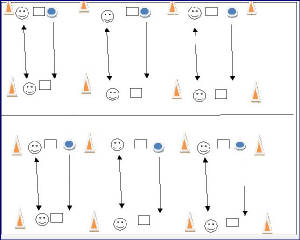
BeachTowelFlingo - Distribute beach towels , towels or small parachutes to partners , who
are scattered around the gym or play area. Each partner group has one ball , either a volleyball , soccer ball, beach ball
, balloon ,blankets or wiffleball . Practice tossing the ball to another partner group so the ball lands in the beach
towel . Each time move closer or furthur apart . Next, use a low volleyball net or a makeshift one , such ss a rope or badminton
net. Give one partner group of two a ball to fling/toss it over the net. The opposing groups will try to catch the ball in
their equipment before the ball hits the floor. Then, return the ball back over the net.
Alternatives are changing the
net height , use diffferent equipment to fling/toss , add more students to each towel or parachute .
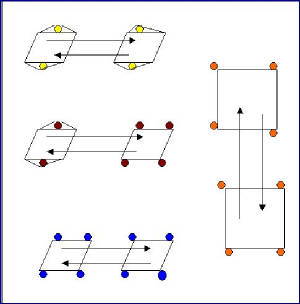
Catch and Chase - arrange the class into a parallel line(s) about 6-8 feet apart . Align the
students facing each(side by side) with partners directly across the line.Make a designated line about 25-30 feet , which
one group will chase after the ball is caught. Give one partner a ball or object that is easily caught . On a signal
, toss the ball back and forth . Play music or whistle the action to stop . The student who has the ball last must run to
the designated line while the partner chases. Score one point for a score and one point for a tag .
Any ball that is dropped or not in play will practice throwing until the next turn.Alternatives are changing the type of throw(
roll, one bounce, no bounce) , change the distance to catch and or run. After each turn have one person , from one group ,
go to the end of the line and everybody else moves one place to the right to get a new partner.
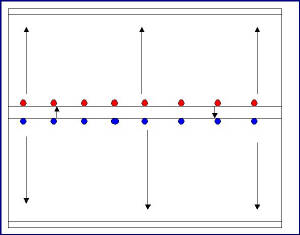
Cone Soccer - make soccer goals with traffic cones in safe areas or grids. Divide the students
into equal or unequal numbers in each area / grid . Each grid will have one ball for each game. Or, in another area , have
an unequal number of students. Use a nerf soccer ball or plastic ball for each game. Alternatives are with or without goalies
; change the ball , distance, rules or number of players. For younger students , using the hands is permitted. Add regulation
goals or makeshift ones.
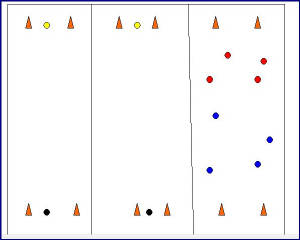
Fitness Circuit - instead of using warm ups/exercises , use a fitness circuit . Establish
a 4 week program and try to beat a previous performance each class session. Before the circuit commences , take a resting
heart rate and after all the stations are done , take another (active) heart rate. If one group finishes before the others
, have them jog in place(only after all 6 stations). The stations are :(30 seconds each)
- Run around 4 designated cones in a square formation set up
- Jump ropes - in the center of the area{count the number}
- Vertical jumps - inches marked on wall
- Ab crunch - place scooter on floor , from the knees , stretch back and forth ,feet off floor , use a mat for comfort from
knees(stretch 3 feet away)
- Reverse push ups- on bleacher facing away , arms stretch up and down
- Step ups - on bleacher or high mat, step up, down ,each leg
Switch places numerically after 30 seconds . Each student will have a station/circuit sheet and pencil to record scores,
which will be placed in a safe area away from the action . Play music for 30 seconds and when turned off , they stop , record
scores and wait for the music to start again.

Flingo Horseshoes - assign the students to various positions safely away from the others with
two hula hoops and a flingo horse shoe, which is a tube or athletic sock that has a tennis ball inside.Close up the open end
of the sock with tape.
Set up the hoops about 20-30 feet apart with students standing beside the hoops with a flingo sock
. They will attempt to toss the flingo inside the hoop or closest to the hoop . Score one point for a flingo closest to the
hoop and three points for adirect hit insdie the hoop. Alterntatives are to move the hoop closer or furthur apart ,
change the type of throw and switch partners or indivdiual games to challenge other students. If keeping score , try to beat
a previous point total instead of against an opponent.

Floor hockey - arrange the class into three separate grids width ways across the floor
or play area . In each grid either have makeshift or regulation goals with equal or unequal groups . Place a makeshift puck
, such as a wiffleball or plastic hockey puck for each grid. Each grid may have either no goalies or one per grid .
Make sure the students abide by all safety rules ,such as high sticking , body contact and tripping with the stick instead
of playing the puck . The equipment should be made of plastic or foam materials and the goalies must wear safety glasses.
Make a crease to keep opposing players from entering the goal area for goalie protection. Play for 3 minutes , and then exchange
one group to enter another grid to participate gainst new players.
Alternatives are using different pucks(safety) , playing more games with traffic cones as goals for more touch time and fewer
players , eliminating all goalies.
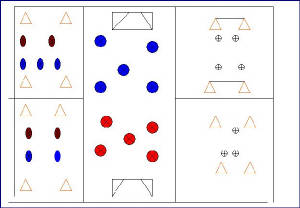
Keep Away - make as many circles formations with the students arm distance apart . Give one ball
to each group , which is made of a foam material such as nerf ball or plastic in texture. Set up the groups with equal or
unequal numbers .
On a designated signal , the ball is passed arround and through the circle while a chosen person(s) try to touch the ball
. If the ball is touched by the center individual or teammate , they exchange places with the person who committed the error.
After a time limit , try new center players until all had a turn to either throw or be a center player. Alternatives are changing
the size of the circle , make different throws( roll, one bounce, no bounce ) and use different types of throwing materials
.
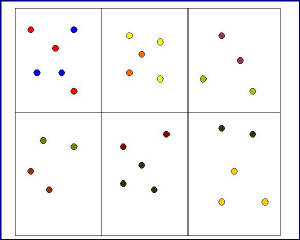
Here is a list of games and activities that are small sided games with alternatives and concepts that can be used as
an addendum to any previous listed games/activities from te left pane of my homepage. Use this as a reference or addition
with extra content to help understand the activities better :
The power of grid games contributes to more participation and touch time . This will increase the play in pressure situations
, strategy for uneven groups , more cooperation and decision making skills. This will take away from winning and losing and
focus more on skill building and fun . There is more movement that doesn’t promote standing around waiting for a turn
or get to touch the ball .
A smaller amount of players is preferable and the rotation of players into different games in such a way as the teams would
keep changing their makeup , which would take away the importance of winning and losing . This would also afford the possibility
of not only playing other teams , but also not playing with the same students the entire time . It is pertinent to focus on
a particular skill to teach or reinforce . The boundaries are set up with all safety features by placing traffic cones or
any safe objects at a secure distance from adjoining groups . With all the skills , games and activities will be alternatives
,which will be appropriate for each grade level with adapted rules , equipment and spatial conditions.
The arrangements in each grid range from various formations , including circular , square or rectangle , triangle and concentric
circles . The students will be arranged in equal or unequal groups . To encourage more touch time , the equipment should be
sub-divided into multi-ball , which is utilized with only two or three per ball . The best scenario in the grids would be
one ball for each student or one between partners in a skill related activity . That skill would be used during the game or
activity to serve as a reinforcement to make it easier to learn the lead up game . Within each grid are different games and
the students will switch grids to try all the skills and activities .
Before any of the games and activities are played , there must be practice sessions that are developed through a rubric
or a scope and sequence. They will proceed at their level of ability and move to the next level when they are ready. Use variations
in each grade by changing the equipment , rules and number of participants . The activities should be geared to beat a previous
performance instead of winning and losing .
The manner in which the game is presented is dependent on how it is modified to enhance success. The games and activities
are divided between the concepts of net and wall games , invasion , striking and fielding and target activities . This can
be accomplished with all students participating regardless of skill levels . The equipment , rules , group size and playing
areas are adjusted into grids. This will enhance decision making skills , tactical awareness and strategy . The students will
play all positions , which will foster working together and illicit questions how a skill is done and what is the responsibility
of playing different positions.
The small groups will endorse many touches , leadership , and help the students analyze what is happening as well as the
skill or task . This will help the students to enjoy the activities and make it more fun to generate more opportunities for
success . The students will be able to maximize individual participation , involve more interaction , and have more opportunity
to develop better concentration since they will be will be included in all games/activities regardless of ability . In many
instances , there won’t be designated positions , which leads to more touches and opportunities to either score or stop
the opponents from scoring . These transitions create an awareness of spatial positions and reaction time . It is important
to utilize appropriate activities so that the students can experience the joy of playing and having fun .
It is important to evenly match the groups physically , the difference between them is the ability to make the correct
decisions . Set up game like situations to give them the freedom to make the decisions they think are appropriate . Balance
the small sided games with a mix of stronger and less skilled players . The stronger players will have to break down the numerical
advantage and the less skilled ones will have to take on more responsibility. There should be no limitations , which gives
them the freedom to express themselves . And , the non-active players can watch and observe what they could have done differently
. This set up from the game situation with players making mistakes can be a correctable teaching tool and finding solutions
.
KEEP IT UP .* Divide the students into each grid equipped with one ball for each group of three
or four students .* Use different types of volleyballs , balloons , play balls , beach ball , volleyball trainer or regulation
volleyball .* Arrange the students in different formations with makeshift nets , traffic cones inserted with broken hula hoops
or a regulation volleyball net .
* On a signal , each group will attempt to keep the ball in mid air for a designated time
limit . * Demonstrate and practice a skill(s) that was previously learned during the lead up activity. * For example , the
skill(s) of volleying and serving will be utilized during the game . * After the time limit has expired , repeat the procedure
to try to beat the previous score of keeping the ball in the air without errors .*
Change the rules according to each classes
ability level * The ball may be played from one bounce , off a net or wall and a body part other than the hands or arms .
* Rotate the students into different grids every 2-3 minutes * They will participate in different formations , use different
types of balls and rules . * But, the same skills must be used in each grid . *Set up a regulation net .* Attach two nets
to the middle section ,which will be tied to the basketball rim(s) or portable standard. * Two regulation games can be played
side by side or if there are available standards or attachments there can be many games .
Here are examples displayed in
each grid :
· In grid #1 make three circles arms length distance apart for volley /hitting skills and bump or dig skills
. Count the number of consecutive hits.
· In grid #2 use a makeshift net ( police tape , strap, rope ) . There will be
two holders in a three on three game . The holders will adjust the levels ( higher /lower) for most consecutive volleys( back
and forth) over the makeshift net . (Change players and holders often). Utilize all types of equipment such as , beach balls
, balloons , or volleyballs . Practice modified serving or set up serve.
· In grid #3-4 Use the tied nets for a regulation
game or use modified rules .Use the makeshift nets for a regulation or modified game . Place hula hoops on the ground on each
side of the net. Try to serve into the hoops .
· Count the number of volleys or serves by alphabet, numbers, months or
from spelling lists.
Variations :
1. Instead of using different formations , the students will be arranged with the
same skill and the same formation , but a different ball .
2. Use equal or unequal number of students .
3. Change
the designated time limit .
4. Change the size of the circle or a formation , depending on the skill level.
Content
: Manipulative skills , cooperation , integration , safety
Equipment : Balloons , beach balls , volleyball
trainers, volleyballs, plastic ball , traffic cones , nerf balls , golf tubes, hula hoops, police tape , straps , ropes, portable
standard
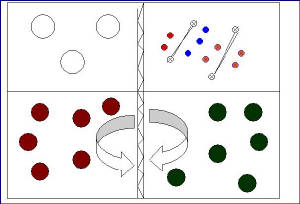
RIP FLAG RUGBY - - Align the students into grids with a regulation rugby ball or a makeshift
one such as , a football or any oblong object similar to the size and shape of a rugby ball . Arrange the groups into either
even or uneven numbered players. Practice lead up skills of passing , receiving , kicking , defensive skills ( rip flag belt
or game jerseys) and running maneuvers ( fake and feint) . Establish rules for each group and add modifications according
to the groups playing ability level . Change equipment often .
Use traffic cones or lines on the floor as scoring and running zones. Divide the area into four different grids , which is
lengthwise on the gymnasium floor , outside football/ soccer field or playground area . Have the players change positions
often to learn the concepts of the game and player positions. No intricate rules so there are no distractions to learn the
basic skills . * Practice ball handling skills in a straight line from one end line to the other * Set up each group in a
five person alignment about a few paces apart
Pass the ball sideways or backwards only * Continue to run until all passes
have been made to the side line .* The first passer on the left runs to the other side of the passing formation * Maintain
a straight line( lanes) throughout the passing process ** Align the students in a circle formation( arms length apart) with
one person out side the first person with the rugby ball . ** On a signal , pass the ball from player to player until the
ball gets back to the starter ** The outside player runs around the circle and back to their original starting position **
Choose a new running player each new turn . *** Practice the grubber(self) and self kick skills from one side line to
the other *** The grubber kick is kicked along the floor(bouncing or rolling) and picked up ; the self kick is from the foot
to the hands while running and receiving in a forward progression . **** Divide half the group with rip tags **** The rip
tag group runs to a side line before the other group rips the tag off .**** Use a ball for passing to another team mate( two
hand pass only).Only the player in possession may be tagged.
LEAD UP GAME/ACTIVITY :
Arrange
the class into four different grids with even or uneven numbered players . Use the sidelines or traffic cones as the scoring
line . Start the game with a grubber kick to the opponents . All passes must be made backwards , which is similar to a hand
off in football . Each player has a rip tag or game jersey . The offensive group has four tries to score .
The defensive
group attempts to halt the progress with a rip tag off . Each ripped tag counts as a try . A ball that lands on the floor
counts as a try . Play continues from that spot . Use a fake or feint to keep the defense off balance . The defense resumes
play after four unsuccessful tries. Players may grubber kick or self kick/catch to progress forward . The defense may intercept
the kick and take over possession . After each ripped off tag , that player must pass the ball backwards to a team mate to
continue play . A forward pass is a loss of a try or possession .All passes are made from two hands
Variations :
1.
Use all equipment available
2. Make more circles
3. Make uneven groups per grid
4. Use the fake and feint skills(
ball is kept in the hands) to escape the rip tags
5. Establish a time limit for the kicking skills , repeat for a better
score
6. Add a defensive player(s) in the passing formation skill
7. Change the size of the grid area
8. Modify the
rules
9. Switch grids often to learn all the skills
10. Practice all skills in the same grid 11. Use a combination of
previously learned
skills ( rip tag football , soccer)
12. Change the number of tries or passes
Content
: Manipulative skills , safety , teamwork , decision making , strategy
Equipment : Rugby ball , football
, play ball , nerf ball, cones , rip tags ,game jerseys
RIP TAG LEAD UP GAME * Arrange the players
into three grids divided by traffic cones with even or uneven numbers. * Use a regulation rugby ball or a makeshift one similar
to a football * Start the game with a grubber kick along the ground * All passes must be made in a backward direction only
* The defense stops the action with a ripped tag or two hand touch with a game jersey *
Give each offense (4) attempts
to score a try. The try is scored over a designated end line and placing the ball on the round * After a ripped tag , the
next attempt is made with a backward pass *Any ball that is dropped may be picked up by the opposition , which was a loss
of possession by the offense * If no score is made within the four attempts , the ball reverts to the opposition at the last
point of contact .* Practice short and long passing ( backwards) and ripping off the tags
Variations
:
1. Use a different ball that is easier to handle
2. Change the number of attempts to score
3. Add self kicks and
catches or grubber kicks to maintain possession
4. Use mirroring for defensive technique similar to football/basketball
5.
Add a place kick after a score – through cones , goal posts or a designated wall marking .
Content:
Manipulative skills, team work, cooperation , safety , International Sport play(integration)
Equipment
: Rugby ball , football, nerf ball , cones , game jerseys, rip tags , traffic cones
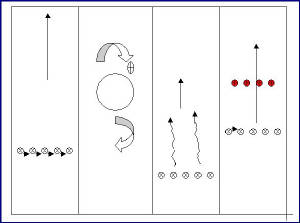
FLOOR HOCKEY - The students are arranged in grids , which are bordered by traffic cones
to divide the area into safe quadrants . The skills and techniques include gripping , stick handling , passing and shooting
. It is important that no body contact be permitted . The control of the stick and puck along with goalie play are essential
to the success of team play and tactical awareness . Each student should have a stick or makeshift object to ensure more participation
. The puck and sticks should be made of a safe substance that is either soft plastic or a pliable material for all safety
concerns
. A wiffleball is recommended as an easy “puck” for all stick handling skills , passing and shooting
skills. Scores can be made at regulation nets , traffic cones , cardboard boxes or golf tubes placed between portable standards.
The rules should be modified to meet the needs of all the students . The skills are practiced to enhance performance for implementation
of tactics and strategy :
Practice walking with the puck positioned correctly in front of the body Stick handle the puck
without looking at the puck , in different directions and around cones The passing of the puck is made from a stationary position
at a wall or at a target . With one puck between two students , the puck can be passed various distances and then increased
or decreased according to the students abilities . To practice passing and receiving , they pass the puck back and forth while
moving. Working together , the partners pass the puck and try to score a goal with one defender The shooting technique is
practiced against a wall or target , from different distances and with a defensive player or an open net .
*Each grid
will have a regulation or makeshift goal.* Establish playing positions for the responsibility to shift from offense to defense
quickly. * During play of the game ,they must realize tactical awareness of why and what they should do . * The constant attacking
and defending will help with handling the quick transitions . * The game should promote plenty of shots at goal and stick
play . * Set up the game with the opportunity to score many goals , which increases participation and challenges at any level
of performance.
LEAD UP GAME/ACTIVITY :
Arrange the class into grids with uneven or even players
. The goals are set on the sidelines or targets made on the wall . Use previously learned skills as practice before there
is a game-like situation . Each player is equipped with a game jersey , floor hockey stick and safety /eye protection .
Switch
positions often to learn the tactics and strategy of offensive and defensive positions. Change the type of puck to slow down
or pick up the pace of play . The game and activities included are as follows:
· Place traffic cones in a long straight
line , which the students will engage in stick play through and around the cones . Set up several areas for more participation
.
· Make targets on the wall for shooting practice
· Use a bowling pin arrangement for more shooting practice
.
Set up more areas for bowling pins .
· Use an open goal net , with or without a goalie
· Play one game per grid
with goals , targets , taped walls , or cones .
· Play 2 on 2 , 3 on 3 or uneven numbers with or without goalies
Variations
:
1. Increase or decrease the playing area
2. Change or modify the rules
3. Use different types of equipment
4.
Switch players to play in different grids
5. Exchange playing positions often
Content : Manipulative
skills , strategy , tactical awareness , teamwork , decision making and safety.
Equipment : Hockey sticks
, pucks , goal nets , cones, cardboard boxes ,golf tubes, tape, safety goggles ,wiffleballs , game jerseys
SIX GOAL HOCKEY - Place one goal at each end of a three court grid width wise in the gym
or outside area ( field grass or asphalt ) * Divide the grids with traffic cones , which are equally placed a safe distance
from the adjoining grids * Each grid may have even or uneven groups * Use different types of equipment , which will be determined
by the playing surface.* Use safe-type floor hockey sticks made of Styrofoam or soft plastic* Provide eye wear / goggles for
each group * Use different balls or pucks conducive to safe play and more free flow of play.*Use regulation or makeshift goals
*
Start the action with a goalie pass to a team mate *No body contact is permitted * The sticks should stay close to the
floor /ground , and make sure there is no high sticking for safety concerns. * Make a restraining arc in front of the goal
area to provide safety for the goalie .
Variations :
1. Change the size of the goal or use cones /
boxes for more goal shots and scoring
2. Use different equipment as sticks( pilo polo )
3. No goalies
4. Make more
grids –less players with or without goal nets or goalies
Content : Manipulative skills , team work
, cooperation , safety
Equipment : Hockey sticks , goal nets , traffic cones , wiffleballs , pucks ,
game jersey , goggles and safety eye wear , pilo polo sticks
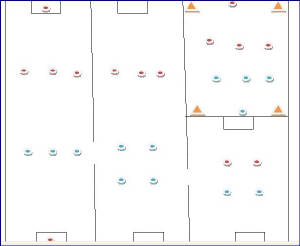
WIFFLEBALL- – this type of striking activity can be coordinated with the baseball
or softball games . The only differences are the types of equipment and any rules that need to be modified. The games and
activities can be played in the gymnasium or school grounds and fields. Practice all the skills and techniques of throwing
, catching , batting , base running and decision making or strategy before attempting to play any lead up games . This will
encourage the students freedom of expression to make them feel more comfortable with their abilities . The equipment should
include one ball for each player , one ball between partners or in small groups for more touch time and participation .
Divide
the students into small groups throughout the area in grids for the practice sessions that are divided in safe areas with
traffic cones. Within in each grid , they will practice throw , catch , hit and base running skills to get them experienced
for any game that will follow. This will support the opportunity to accumulate more child-centered activities with more chances
to succeed . The same skills can be attempted within each grid or variations depending on skill or performance levels . There
should be a progression for all the skills to be mastered and no complicated rules to hinder their success.
LEAD
UP GAMES /ACTIVITIES : ANYTHING GOES. * Arrange the class into three grids that are divided
by a line of traffic cones . * Each grid will be involved in three different games at once . * The first grid uses a batting
tee * The second grid will use a self toss or a one bounce toss from the pitcher * The third grid will be involved in a modified
regulation game . * In each grid the rules will be adapted and no scores will be kept . That is , each group will bat for
3 minutes with no a no (3) out rule and switch positions .* There will be set bases but no playing positions , only a safe
, scattered position
A regulation wiffleball and bat will be used in each grid .* The bases are either poly spot or a
rubberized material . *The players run the bases in regulation order . *Any ball that is caught must be returned to a designated
pitcher position .* At that point , all base runners must stop and or freeze at that last spot . *Within in each grid , the
rules can be modified to increase more touch time and participation . * Use variations for less skilled players and to increase
the flow of the game with less standing around :
Variations:
1. Use different striking equipment
such as a kickball ; a volleyball to serve; a paddleball and tennis ball ; soft foam ball and soft bat .
2. Run the bases
in any order or give the choice of more than one on each base or make only two bases ( home and second – 30 feet apart
)
3. Throw the ball to each player to stop the base running process.
4. Have opportunities to choose what striking
element to use each turn at bat
5. Use a different equipment each new turn at bat that matches the type of ball ( wifflebat
–wiffleball ; rolled ball –kickball ; paddleball racquet- tennis ball ; soft bat-soft ball ; batting tee –
wiffleball)
Each grid has the opportunity to change the type of throw at any time at the request of the player at bat
. * Place a box of ball at each pitching position in the event of any changes * Place all types of striking equipment safely
away from the person at bat for any changes . * Use different colored wiffleballs to differentiate the grids.
Content
: Manipulative skills , safety , decision making , strategy , cooperation ,teamwork
Equipment : Wiffleballs
and bats , batting tees, volleyballs , kickballs , soft –like balls and bats , paddleball racquet, tennis balls , traffic
cones

Arrange the students into small groups between traffic cones facing a wall
or bleachers in 12-15 courts . * Each court will have one tennis ball per game . * Divide the groups into even or uneven players
.* Choose one player from each group to be the first leader to start the game. * To score a point , the player throws the
ball of the floor on one bounce , rebounding it off a wall or bleacher . * The opposition players must catch the ball before
it hits the floor * Any ball that hits the floor scores one point or run . Any ball that is caught is an out . * After 3 outs
, switch positions * The next player to rebound the ball waits in between the traffic cones , which serve as boundaries .*
Any ball that lands outside the cones counts as an out. * The ball must bounce off the floor first . * Repeat the procedure
and if there are three consecutive errors will constitute an out.
Variations : 1. After a designated time limit , switch
one group to another grid in around robin set up . 2. Use a different ball 3. Change the size of the playing area 4. Play
1 on 1 , 2 on 2 , or 3 on 2 in some grids 5. Change the ball to a play ball or volleyball and throw it off the wall similar
to a racquetball game( or doubles tennis) with alternate catches . Any ball that is caught must be thrown from that position
or to a teammate.
Content : Manipulative skills , decision making , strategy , team work , safety
Equipment
: Tennis balls , play balls , volleyballs , traffic cones
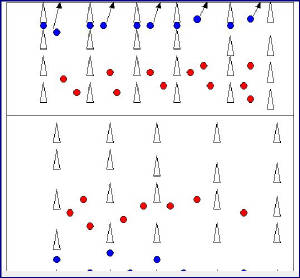
SPEEDBALL- Arrange the players into two grids on each side of a designated half way line
in the gymnasium or outside field area.* Place one cone on each side of the halfway line for one of the scoring lines. *The
grids are set up width-wise with goal nets centered at the midway point between the cones. * Make a restraining line(arc)
in front of each goal * Place another cone on each side of the goal net about 3-4 feet from the post * This will be used as
another scoring zone.
The goal net will be the final scoring zone. * Before the game is played , the players must have
knowledge of a combination of previously learned skills in football , volleyball, basketball and soccer. * Any ball that is
on the floor will include all soccer skills except the hand ball penalty. * A ball that bounces may be juggled to the hands
off any body part first * A rolled ball can be set up to the hands by having the ball run up a leg , then to the hands.* NO
ball may be picked up by a player except the designated goalies.* The ball may be placed between the feet and thrust upwards
to the hands* The player(s) may run with the ball from a throw by any other team mate
All players will wear game jerseys
or rip tags. *The goalie must only roll the ball to a team mate .* Start the action with a regulation basketball jump ball
The defense may stop the action by a tag or ripped tag .* There is a change of possession at that point .* The ball is placed
for a soccer style kick by the group that stopped the action *This will be a free kick with the opposition three paces away
.* An air ball may be volleyed to another team mate * There are several ways to score points: A kick into the net is worth
(3) points ; a kick between the cones by the goal net is worth one point ; a throw into the goal net is worth two points ;
a running score past the goal line after three consecutive throws similar to a touchdown is worth (5) points
The goalies
may not rip or tag the runner. * The player set up is a scattered position within the boundaries.* The goalie set up is one
player inside the net and one more player each between the cones and post area .* After a score , the goalies roll the ball
to a team mate* Switch positions often between players and goalies.* Use a nerf ball or any soft , safe object
Variations
:
1. Make more than two grids
2. Modify the rules : The goalie may throw the ball on one or no bounces
; use different equipment ; make more goalie nets
3. Give three chances to score instead of loss of possession when tagged
Content:
Manipulative skills , team work , cooperation , safety , follow directions
Equipment: Nerf ball , soccer
ball , play ball , goalie nets , game jerseys , rip tags , traffic cones
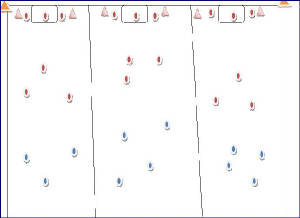
ULTIMATE FLAG FOOTBALL
- Arrange the players into three grids with different colored rip flag belts . * Use a nerf or regulation
football according to their ability level . Divide the three grids equally between even or uneven numbers . * Place traffic
cones between each grid and designate a scoring line , which will be the sideline areas on each side of the basketball court
or outside field area. * Modify the rules to make the game easier to understand and allow for more success in performance
levels . * The football may be thrown in any direction .* Any football that drops to the ground results in loss of possession
.*
Start the new possession from that point. * There is no running allowed until the third consecutive successful throw
and catch *Rip tags may be taken off only after that task .* * The one exception occurs with an interception * After three
passes , a score is counted with a run past the side line or another pass to a team mate that is over the end line. * Each
change of possession is a kick along the ground that is picked by the opposition .* That first player must maintain a stationary
position until the first throw has been made.
Establish a three foot safety zone after each catch * Limit the throw to
a three second count. * Even thought there are no set positions , it is appropriate to institute the defense into a “mirroring”
technique for more movement and participation and make sure the offensive players move in various pass patterns to break free
for a completed pass . * Before any game is played , it is important to practice the lead up skills intrinsic to the game
Variations :
1. Utilize uneven numbers for decision making and strategy skills
2. Each player
must catch the ball at least once before a score is counted.
3. Change the size of the field
4. Change the equipment
( rugby ball , nerf play ball , regulation football )
5. Running is permitted after any catch , but this results in loss
of possession
Content : Manipulative skills , team work, cooperation , safety , strategy
Equipment
: Nerf football , regulation football , rugby ball , traffic cones, rip tags , game jerseys
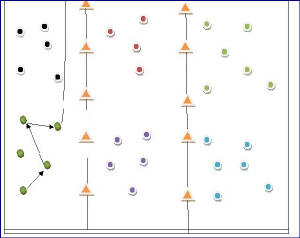
TARGET BALL - Divide the players into two grids on each side of the mid court line of the
basketball court . * Use the two side basketball hoops , and play the width of the court Distribute one large beach ball or
Kin Ball for each game.* Start the activity with a volleyball set up * Any ball that touches the floor will result in a loss
of possession* The ball may be caught or hit towards the opponents basketball hoop * If the ball is caught that player must
remain stationary and replicate the serving or set up process. The ball may be hit similar to a volley to self or to a team
mate
The defense may catch the ball or knock it away if the ball is volleyed out of the stationary position . * If the
ball hits the backboard , it will count as three points ; a ball hitting the rim is two points ; and a ball that hits the
net is one point . * Any ball that is caught off the backboard or rim by the defense from the rebound will negate any points
* The defense will continue towards the opponents basketball hoop to repeat the procedure
After a score , the opponents
will start from under their basketball hoop .* Any ball that goes outside of the lines or crosses into the adjacent game(mid
court) is out of bounds and a loss of possession . * Any side walls are also out of bounds * The ball may be held upwards
and overhead by two players for a push serve by a team mate .
Variations :
1. Add a third grid
and use a designated square target taped on the wall. Inside the square is three points : hitting the taped line is two points
; hitting the wall is one point . * The defense may catch the ball off the wall to negate the score .
2. Change the number
of players
3. All catches must remain in the stationary position – no running permitted –only passing
4.
Use a smaller beach ball
5. Use portable basketball hoops
Content : Manipulative skills , team
work , cooperation , strategy , safety
Equipment : Beach ball , Kin Ball , game jerseys , tape , cones
,portable hoops
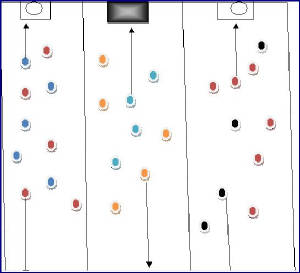
TUMBLING ADD ON - This activity is similar to the “jigsaw” technique , which
promotes working together in small groups to complete an activity to breakdown the elements into a final outcome * Divide
the students into 4-6 small groups *Each student will work on a designated skill and then add it with the others for the final
process in the form of a tumbling routine * Give each group a few minutes to work out the floor pattern that will be viewed
by the class in a one minute performance. * The skills will be critiqued after each routine *
The skills will include
balances, dance and tumbling maneuvers . * All students will be included regardless of skill levels.* Practice the skills
and routine within designated grids , which include various tumbling mats in safe positions . * The students will work out
the routines within the grid and keep their movements along the designated floor patterns. * Choose one student to begin the
routine from their floor pattern , and then at that point of completion , the next student will be waiting to continue the
pattern
Continue that process until all had a turn to complete the routine * As an alternative , the other groups may
be practicing their routines and floor patterns while the first group is presenting their performance * Skills may be linked
together and count as “one” pass , such as a series of 2-3 leaps or handsprings in succession * Add upbeat music
to choreograph the connections and final routine * Use traffic cones to divide the grids .* Before the routine , place the
students at their designated spots to await their turn without too much hesitation .
Variations :
1.
Use smaller groups in each grid
2. Switch students often into different groups and grids
3. Use different lead up sports
, such as skateboarding or track and field for those students who may lack tumbling skills . ( twists , turns , jumps )
4.
While the groups are practicing have one group watch the routine and comment about the routine, floor pattern or connections
between starting and stopping .( where one skill stops and the next one starts )
5. Change the format to all tumbling skills
or all dance and locomotor skills .
Content : Locomotor and non-locomotor skills , lead up tumbling skills
, strategy, working together , cooperation , safety
Equipment : Tumbling mats , music , cones ,paper and
pencil( patterns and directions of routine)
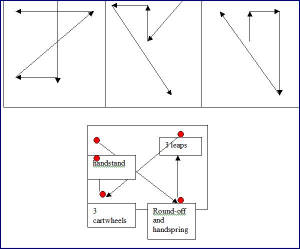
VOLLEY LOON - Set up a regulation volleyball net and attach two more nets at the center
of the regulation net.* The two additional nets are attached to the basketball rims or portable standards.* The quadrant and
grids are the playing area for groups of 4-6 players.* Distribute one ball per group .* The players are aligned in a single
file facing the net * Use a balloon or beach ball.* The first player sets up(self volley) the ball or balloon in the air and
then runs to the other side of the net while the next player in order keeps the ball off the floor*
The next player in
line repeats the process until all players are on the opposite side of the net * The task is completed when the group returns
to the original starting position * Any ball that is mishandled or hits the floor , the entire group must start over.* The
last person in the group must hit the ball over the net to complete the task .*
Variations :
1.
Use a regulation volleyball or trainer
2. Change the height of the net
3. Increase the number of self volleys
4.
Change the number of players
5. Keep track of time , and then repeat to beat a previous score
Content
: Manipulative skills , team work , cooperation, strategy , safety
Equipment: Volleyball nets , portable
standards , balloons , beach balls , regulation or trainer volleyballs
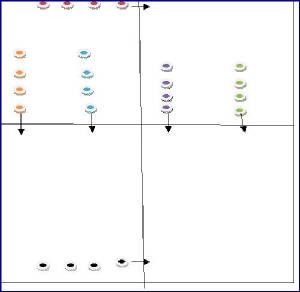
VOLLEYBALL HOOPS - * Arrange the players into small groups near each of (4- 6)basketball
hoops or portable standards* Align each group in a circular position arms length distance apart*Choose one player to start
the activity with a set up volley * Use a regulation or volleyball training ball * Each leader sets the ball up to any player
* The ball must be hit /volleyed to each player * The last person who has received the pass tries to set up the ball for points
hitting the rim , backboard or net
Two points( extra) are scored for any ball that is similar to a basketball goal shot*
Any ball that hits the rim scores (2) points ; hitting the backboard hit is (1) points ; the net is worth (1/2) point .*All
hits/volleys are consecutive *Switch new leaders each time . * Any ball that is caught or pushed isn’t counted and the
leader starts over for each infraction .
Variations :
1. Change the size of the circle
2.
Add more volleys and establish a time limit(beat a previous score)
3. Change the type of striking skill ( bump, dig , set
up )
4. Change the type of equipment
5. Change the scoring if using portable basketball hoops
Content
: Manipulative skills , team work, cooperation, strategy , safety
Equipment: Balloons , beach balls ,
nerf balls , volleyballs , portable basketball hoops
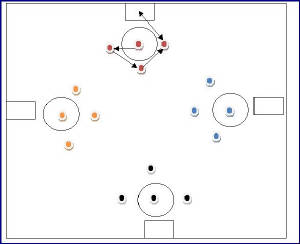
THREE RING CIRCUS Divide the class into three different grids divided by traffic cones width-wise
in the gym or outside field area* Each grid will have a different implement* Distribute game jerseys or rip tags to each player
* Place a scoring zone on each end of the playing area* The scoring zones are end lines , boxes , goals or any available makeshift
object.*There will be a different scoring procedure at each grid * The starting implements are a frisbee , deck ring and flingo
, which is a tennis ball inside a sock * Each group will try to score at the opponents end line area
* Any object that
is caught stops at that point* No score can be made until three consecutive catches * Any object that is dropped or goes out
of the playing area results in a loss of possession* After each score , the object is tossed from the end line area * There
is no running permitted after a catch * No body contact * The scores will be counted inside a goal net , box or a catch passed
the end line by a team mate * A rip tag or two hand touch after the third catch results in loss of possession .
Variations
:
1. Switch grids often
2. Change the numbers of players
3. Change the type of equipment
4. Change
the size of the playing area
5. Add more grids for more touch time
6. Allow running after the third catch
7. Use
makeshift targets on the wall for scoring
8. Use standing golf tubes inside cones for a scoring zone(deck rings)
9.
No goalie play
10. Give each group four tries to score
Content : Manipulative skills , team work,
cooperation , safety , strategy
Equipment: Goal nets , boxes, deck rings, Frisbees , game jerseys, rip
tags , traffic cones , golf tubes
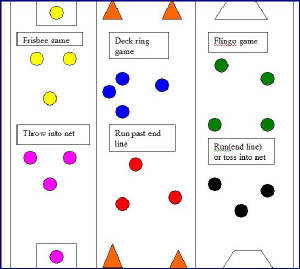
SOCCER GOLF - Divide the class into as many available grids in the gym or outside field
area that are divided by traffic cones * Each grid will have 3-4 different colored soccer (nerf) balls *Place three goal nets
, cones , boxes or any makeshift goals on a designated end or side line *Each group must kick the ball into all three goal
scoring areas similar to a putt in golf * After the first “hole” has been completed , they will attempt to make
another shot at goal at a different “hole.”* After a score , the ball leaves that area and into the playing area.*
After each goal has been made at each “hole” , time the group to accrue a score that is repeated a second
time to beat the previous performance. * Use soccer skills of passing , dribbling , and trapping * The ball may be stolen
at any time (feet only) * Use a light –sized ball to make the scoring easier ,safer and less intrusion to adjoining
grids.* Use rip tags or game jerseys for the teams
Variations ;
1. Change the number of players
2.
Change the size of the playing area
3. Change the type of equipment
4. Make the goals/ holes larger or smaller
5.
Use tape on the walls for the “holes”
6. Use hurdles for outside play for goals / holes
7. Add or subtract
the number of balls
Content : Manipulative skills , strategy , decision making , team work, cooperation
, safety
Equipment : Goal nets , boxes, cones, hurdles, tape , nerf balls , safety balls , game jerseys,
rip tags , open ended appliance boxes
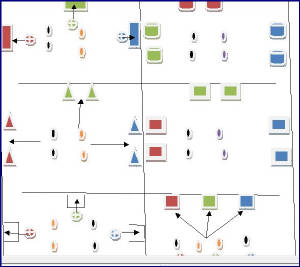
KICKBALL MANIA
* Arrange the players into small grids throughout the gym floor or outside play area * Each grid will have 2-6 players
* Use one soft kickball that is made of foam or any light material * Place two traffic cones about 20-30 feet apart depending
on the skill level and age related grade. * The kicker has to run from cone to cone and back each turn * The assigned fielders
must either throw the ball at the cone or to a designated catcher * Make a spot on the ground for the catcher to stand , which
is a safe distance from the kicking cone
Give each kicking group three minutes to score as many “runs” in
that time limit. * Switch places often * There are no outs , but only scores * Any ball that is caught is returned to the
catcher or thrown at the cone , not at the kicker / runner .* A designated pitcher rolls the ball to the kicker
Variations
:
1. Change the type of ball
2. Change the number of players
3. Change the distance between the cones
4.
The kicker may stop the ball , then kick it
5. Switch fielders an pitcher often
6. Have no pitcher , but throw a fielded
ball to the pitcher instead of a catcher
7. Beat a previous individual score each time
8. Switch players into any grid
in a round robin type activity
Content : Manipulative skills , strategy , team work , cooperation , safety
Equipment
: Traffic cones , nerf balls , beach balls , soft –type play ball
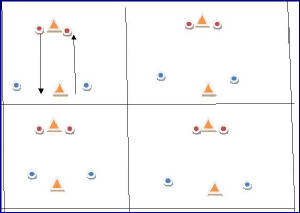
TUMBLING MAT SOCCER Place folded tumbling mats at each goal area on the end line or side line within each
grid * Arrange the players into small groups (3-4) in each grid * Utilize all soccer / scooter rules * Give each player a
scooter and game jersey * Start the activity at one end of the goal area * Any ball that is kicked inside the folded tumbling
mat scores one point* There are no goalies *
After the score , the opposition starts at that point * All equipment must
be made of any safe material ( nerf ball , play ball , beach ball , kin ball ) * All safety scooter rules should be in effect
at all times * Set up traffic cones to divide the grids
Variations :
1. Set up more than one
tumbling mat on end
2. Use soccer goal nets
3. Divide the groups to even or uneven players
4. Eliminate the scooter
play
5. Switch players into different grids
Content : Manipulative skills , team work , cooperation
, safety
Equipment : Traffic cones , nerf ball , play ball , game jerseys , scooters, tumbling mats, goal
nets , kin ball beach ball
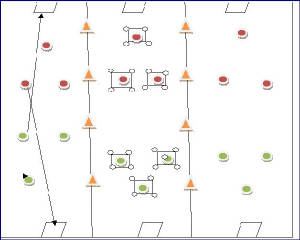
OBSTACLE COURSE
- Set up a station or obstacle course( 6-8 groups) using all available equipment including tumbling mats , hula hoops ,
short vaulting horse or "buck" , low balance beam , tumbling "crash" mat , beat board , and traffic cones .
Arrange the
students in a file formation behind the station/obstacle course a safe distance away about 6- 8 feet . Play music or establish
a designated time limit . At each place , there should be available space to perform assigned tasks at leat two turns , except
at the vault horse , which needs the safety mat . In this case , the students take a turn and come back to the original position
and repeat the task .
Switch places left to right so they can perform the skills /tasks . The last line last line on the
left will go to the first position on the far right as shown in the diagram . Here are the following stations :
#1
Run up to the vault horse from the beat board or folded mat and jump on and off into the crash mat #2 Hurdle over three folded
tumbing mats#3 Crawl under the broken hula hoops insdie traffic cones#4 Zig-zag side to side with both feet inside hula hoops#5
Either jump side to side or walk on the low balance beam#6 log roll / any tumbling skill
Variations
1. Add turns in the air off the Vault horse
2. Step over /dive / skateboard skills over the mats
3. Crawl backwards
4. Use one foot or alternate between one and two foot take-offs
5. Leaps / turns /jumps
6. Separate two tmbling mats and leap over (running long jump)
7. Play music , turn off , try to freeze them

TWO PASS Place as many footballs on the floor in a scattered formation within the basketball
court lines or outside facility. * The footballs should be placed about 10 feet apart .* Match up any two designated partners.*
On a signal , they will run to any ball and make two consecutive ,complete passes . Replace the ball on the floor and run
to a different ball to repeat the process.* Establish a time limit to throw and catch as many different balls . *Repeat the
activity to beat a previous score
Alternatives :
1. Use a different type of ball ( soccer ,volleyball
, rag ball, wiffleball or distribute all the different types of equipment instead of the same ball each time
2. Add more
passes
3. Choose new partners each time.
Change the type of ball and skill ( if a soccer ball ,pass it ; a volleyball
, volley it ; and a wiffleball , bounce ,no bounce)
4.Increase or decrease the distance between partners.
TWO
PASS TAG .
Apply the same rules , but this time stop the action with a whistle or music.
The last person
to receive the ball must run away from their partner.
The other partner must tag the partner within 10 seconds.
Use
a hand tag or use rip flag tags.
Content: Co-operation , team work, Manipulative skills , safety awareness
Equipment
: Footballs ,play balls, soccer balls , frisbees
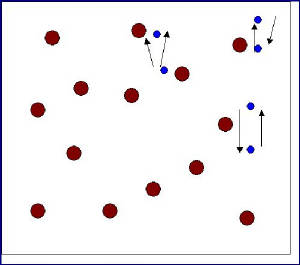
SIGN ME UP
In the self testing procedure , the students are assigned near arranged tumbling mats ,
which are scattered throughout the gymnasium . At each tumbling mat will be a traffic
cone with a sign posted with the skill that will be practiced. They will get many
opportunities to perform the skill and finish by being observed by the teacher
The
tumbling skills are posted with butcher –block paper on the walls or bleachers . At each
poster will be a marker , which the student will sign when the skill is completed
successfully. Before this takes place , the students practice the skills during regular
physical education class.
Next , the students return to a different tumbling area and
proceed to another skill . They will be given opportunities to engage in alternatives if the
skills are too difficult to master in a scope and sequence procedure as follows :
1. Mat #1 – forward somersault or log roll
2. Mat #2 – backward somersault or egg roll , back shoulder roll
3. Mat #3 – cartwheel or ½ cartwheel
4. Mat #4 – handstand or short kick handstand , with a helper /spotter , mule kick
5. Mat #4 – round –off or cartwheel with 1/ 2 turn
6. Mat #6- frog head or hand balance or frog balance with help / spotter
7. Mat #7- balances – “v” sit , straddle sit , arabesque or “Y” scale
8. Mat #8- handsprings or with help / spotter
9. Mat #9 –advanced skills (only)
10. Mat #10- twists ,turns , rotations ,( 180 degrees or 360 degrees
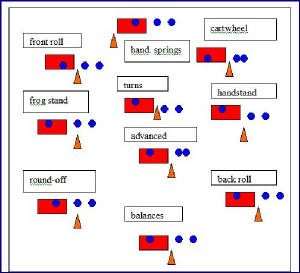
FLIP AND SET
Divide the players into small groups , which are scattered around the playing area.
Each group is equipped with one parachute and several volleyballs or an alternate
ball for easier handling . Half of the group holds and flips the volleyballs off the
parachute ; the other group of players surround the parachute . Any ball that is
flipped off the parachute is returned with any previously learned skills
For the
primary grades , it may be a catch and return or a catch and set up return . The
intermediate / middle school grades may return the ball directly from a set up or a
bump or dig . Score one point for each return and then repeat to improve on a
previous performance . Switch places often .
Alternatives :
· Score additional points for the flipping group when the ball hits the ground
· Play the ball off one bounce
· Have the flipping players move in different directions
· Add more volleyballs
· Use small parachutes
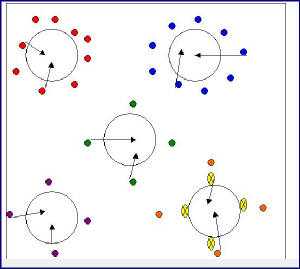
PAC MAN
Align the students on any of the marked lines of the basketball and volleyball dimensions.* On a signal , they will move in
any direction until a different command is given.* Follow the lines until two students meet together
.* At this juncture, one of the students must turn to the opposite direction.* Change the type of locomotor skills often .(
walk, run ,skip, hop ,etc.)*Chose one student to be the tagger (Pacman),which is taken from the computer game of the same
name.* If tagged , that student becomes the new Pacman.* Practice the skills to ensure safety , following directions, pathways,
cooperation .
Alternatives:
* Use more than one Pacman. *
If tagged , that student steps off the line and
waits for another student to release them back to the game( hand tag).*
Change directions
often( a whistle or music)
.*Use a safe object for tagging(pillow, stuffed animal).
Add a basketball skill of dribbling , which will have anything that bounces and can be dribbled. Choose 2-3 "ITS",who
will try to tag the other dribblers or make them lose control of the ball . Switch taggers often.
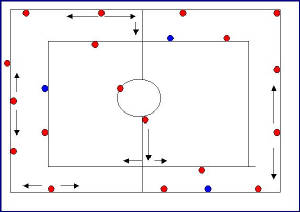
TIC TAC TOE Arrange the class with partners with a tic-tac-toe card(board) , and markers
and bean bags . * The fitness card displays exercise and tasks learned in previous lessons . Use the beanbags to toss onto
the card in an underhand motion . * Make a designated starting line about 5 feet from the card. *
Choose one student to
be the “X” and the other the “O “ . * The students will play the game of tic –tac-toe that requires
them to do certain tasks or exercises * Take turns tossing the bean bags , then place the markers in that spot * For the marker
to count , the bean bag must land in the square , and not on any lines . * The object is to get three in a row from any direction
When the bean bag lands correctly , both students performs that skill or exercise. * The game continues until there is
a tic –tac-toe match .* All equipment is safely placed near the cards or on the sidelines . The card grid can be placed
on the floor or at an angle against a box or container.
Variations
:* Use a single cardboard cutout as an example for
a few turns so they can understand the procedure
.* Change the distance and the type of throwing skill .
Mix the cards
with all skills , exercises or novelties .
* Use physical education words on the cards.
*Use deck rings to replace
the bean bags or any object that doesn’t slide easily.
Content : Co-operation , integration , safety
awareness , manipulative skills
Equipment : Markers, bean bags , frisbees , plastic balls , basketballs
, footballs, soccer balls , volleyballs ,deck rings ,box or container
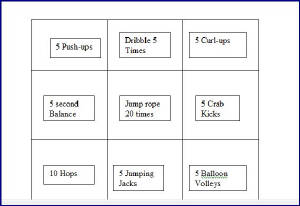
|